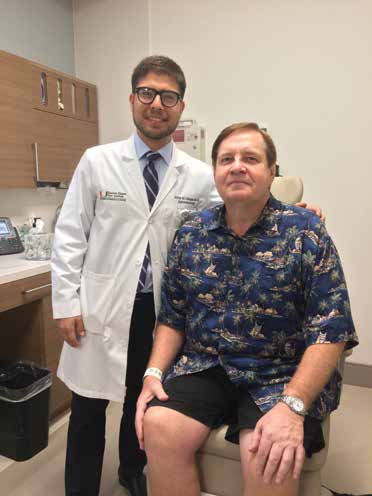A Very Grateful Patient

BASCOM PALMER EYE INSTITUTE NAPLES
Gary Sullivan understands the importance of taking care of one’s eyes. Three decades ago, he was successfully treated for cataracts and glaucoma, allowing him to continue his career as a business professor in Texas and enjoy his retirement years in Naples and New Mexico with his wife Linda.
So, when Sullivan began losing vision in his left eye, he knew something was wrong. Initially, his optometrist in Texas couldn’t see a problem. But when Sullivan returned a year later for his next check-up, the news wasn’t good. “There was a benign tumor at the head of my optic nerve near the macula,” he said. “While it wasn’t cancerous, the tumor could not be removed surgically because of its position.”
Although his eye doctor said nothing could be done to prevent a steady loss of vision from the tumor’s leakage of exudates, small, hard clumps of cells seeping into the retina, Sullivan refused to give up. After returning from their summer home in New Mexico in 2015, the Sullivans came to Bascom Palmer Eye Institute at Naples.
Using the Institute’s advanced optical coherence tomography (OCT) imaging system, Stephen G. Schwartz, M.D., associate professor of ophthalmology and medical director, quickly identified Sullivan’s problem and referred him to Víctor M. Villegas M.D., an assistant professor of clinical ophthalmology who specializes in retinal tumors.
“Gary’s vision loss was being caused by the leakage from the blood vessels in the tumor,” Villegas said. “The traditional treatment for this type of lesion is to use a laser. But because the tumor was at the head of the optic nerve, there was a higher risk of damage.”
Instead, Villegas and Sullivan discussed treating the vision loss with Avastin, a medication originally developed as an anti-cancer drug that is also effective in treating age-related macular degeneration (AMD) – a discovery made in the early 2000s by Bascom Palmer’s Philip Rosenfeld, M.D., Ph.D., professor of ophthalmology.
“I had used Avastin in my training, and saw that it was effective in treating multiple small benign tumors in the eye,” Villegas said. “We felt there was minimal risk to Gary’s vision, so we decided to go ahead. If the medication didn’t work, we could treat the tumor with a laser later on.”
Fortunately, the experimental treatment worked, and Sullivan’s vision quickly began improving after each of his monthly injections. “After my first injection, I went out on the golf course and shot a hole-in-one,” Sullivan said. “My vision has improved to nearly 20-20 and I can read again without a magnifier.”
While Sullivan’s tumor is still there, the most recent OCT scans show that it’s not growing. “At this point, I can live with the tumor,” he said. “To be able to see clearly again – to me that is borderline miraculous. I can’t say enough good things about the excellent care I received from Dr. Villegas and the entire team at Bascom Palmer Eye Institute at Naples.”



Leave a Reply
Want to join the discussion?Feel free to contribute!